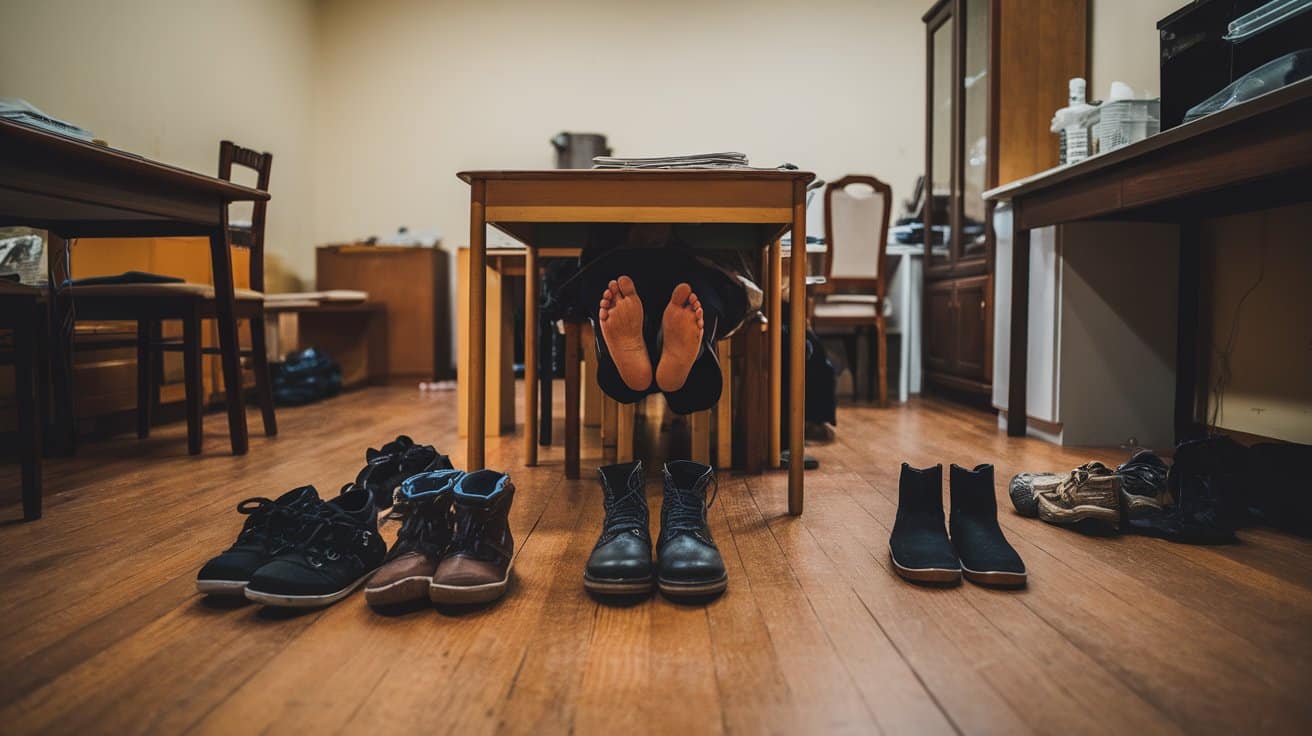
Fear comes in many forms; for some, it takes the shape of feet.
Podophobia, the intense fear of feet, might sound unusual to many, but for those who experience it, it’s a very real and often challenging part of daily life.
This fear goes beyond a simple dislike or finding feet unattractive – it’s a powerful anxiety that can affect various aspects of a person’s life.
In this post, we’ll examine pedophobia in greater depth.
We’ll explore what it means to have this fear, what might cause it, how it impacts those who live with it, and ways to manage or overcome it.
Whether you’re dealing with this phobia yourself, know someone who is, or are simply curious to learn more, this guide aims to shed light on a misunderstood condition.
Let’s step into the world of podophobia with empathy and understanding, recognizing that while fears may seem irrational to others, they’re very real to those experiencing them.
What is Podophobia?

Podophobia is an intense and persistent fear or discomfort related to feet.
This condition goes beyond a simple dislike or disgust towards feet.
People with podophobia experience strong negative reactions when confronted with feet – either their own or those of others.
The term “podophobia” comes from the Greek words “podos” meaning foot, and “phobos” meaning fear.
It’s classified as a specific phobia, which is a type of anxiety disorder focused on a particular object or situation.
Key aspects of podophobia include:
- Intensity: The fear is often disproportionate to the danger posed by feet.
- Persistence: The fear lasts for six months or more.
- Interference: It significantly impacts daily life and routines.
How Podophobia Affects Different People
1. Severity Spectrum
- Mild: Slight discomfort when seeing or thinking about feet.
- Moderate: Active avoidance of situations involving feet.
- Severe: Panic attacks or extreme distress at even the thought of feet.
2. Focus on Fear
- Own Feet: Some people fear only their own feet.
- Others’ Feet: The fear may be about other people’s feet.
- All Feet: In some cases, the fear extends to all feet, including images or mentions of feet.
3. Specific Triggers
- Visual: Seeing bare feet or even covered feet.
- Tactile: Fear of touching or being touched by feet.
- Conceptual: Anxiety triggered by discussions or thoughts about feet.
Common Reactions to Feet in People with Podophobia
Physical Symptoms
- Rapid heartbeat
- Sweating
- Trembling or shaking
- Shortness of breath
- Chest pain or tightness
- Nausea or stomach upset
- Dizziness or lightheadedness
- Feeling of unreality or detachment
Emotional and Psychological Responses
- Overwhelming anxiety or fear
- Desire to escape the situation
- Feeling of losing control
- Anticipatory anxiety about potential exposure to feet
- Shame or embarrassment about the fear
- Avoidance behaviors
Cognitive Reactions
- Intrusive thoughts about feet
- Difficulty concentrating when feet are present or mentioned
- Overestimation of the threat posed by feet
- Negative self-talk or catastrophic thinking
Impact on Daily Life
Podophobia can significantly affect various aspects of a person’s life:
- Social Interactions: Avoid beaches, pools, or situations where feet might be visible.
- Personal Care: Difficulty with foot hygiene or wearing certain types of shoes.
- Relationships: Strain on intimate relationships due to fear of partner’s feet.
- Professional Life: Challenges in jobs requiring foot exposure (e.g., healthcare, fitness instruction).
- Recreation: Avoidance of activities like yoga, martial arts, or getting pedicures.
Distinguishing Podophobia from Normal Dislike
It’s important to differentiate between a general dislike of feet and podophobia:
- Intensity of Reaction: A dislike might cause mild disgust, while podophobia triggers intense fear or panic.
- Impact on Functioning: General dislike doesn’t typically interfere with daily activities, unlike podophobia.
- Controllability: Those with a mild aversion can usually manage their reactions, while those with podophobia often feel their fear is beyond their control.
Understanding the complexity and variability of podophobia is crucial for recognizing the condition and seeking appropriate help. While it may seem unusual to some, for those affected, it’s a real and challenging experience that often requires professional support to overcome.
Causes of Podophobia
1. Traumatic Experiences
Many cases of podophobia stem from negative encounters involving feet. These may include:
- Accidents or injuries to the feet
- Witnessing distressing foot-related incidents
- Embarrassing situations involving feet
Such events can create a lasting association between feet and fear or discomfort.
2. Learned Behavior
Sometimes, the fear of feet is picked up from others:
- Parents or siblings showing disgust towards feet
- Friends or peers expressing strong aversions to feet
- Cultural norms that view feet as unclean or taboo
Children may absorb these attitudes and develop their fear of feet.
3. Underlying Anxiety Disorders
Podophobia can be a symptom of broader anxiety issues:
- Generalized anxiety disorder
- Obsessive-compulsive disorder (OCD)
- Social anxiety disorder
In these cases, the focus on feet may be an expression of overall anxiety tendencies.
4. Sensory Processing Sensitivities
Some individuals may develop podophobia due to heightened sensory reactions:
- Hypersensitivity to textures associated with feet
- Strong aversions to foot odors
- Visual sensitivities to foot shapes or movements
These sensory issues can contribute to the development of fear and avoidance behaviors.
5. Evolutionary Factors
Some researchers suggest that fear of feet might have evolutionary roots:
- Feet as potential carriers of disease or parasites
- Association of feet with vulnerability (being knocked off balance)
While not a direct cause, these factors might make some people more prone to developing foot-related fears.
6. Media and Cultural Influences
Exposure to negative portrayals of feet in media or cultural narratives can play a role:
- Horror movies featuring foot-related scenes
- News stories about foot diseases or injuries
- Cultural taboos surrounding feet in certain societies
These influences can shape perceptions and contribute to fear development.
7. Lack of Exposure
In some cases, limited exposure to feet in daily life can lead to discomfort:
- Growing up in cultures where feet are always covered
- Personal habits of avoiding bare feet
This lack of familiarity can make encounters with feet feel strange or frightening.
8. Genetic Predisposition
While not a direct cause, genetic factors may increase susceptibility:
- Family history of anxiety disorders or specific phobias
- Inherited personality traits like high neuroticism
These genetic influences may make some individuals more likely to develop phobias, including podophobia.
Understanding these potential causes can help address the root of podophobia and find effective ways to manage or overcome the fear.
It’s important to note that a combination of factors often contributes to this phobia’s development.
Coping Strategies and Treatment Options
1. Self-Help Techniques
Individuals with podophobia can try several self-help methods:
- Relaxation exercises: Deep breathing, progressive muscle relaxation, or meditation
- Mindfulness practices: Focusing on the present moment to reduce anxiety
- Positive self-talk: Challenging negative thoughts about feet with more balanced perspectives
- Gradual exposure: Slowly introducing foot-related images or situations in a controlled manner
- Education: Learning about foot anatomy and function to demystify the fear
These techniques can help manage anxiety and build confidence in dealing with foot-related situations.
2. Cognitive Behavioral Therapy (CBT)
CBT is often the first-line treatment for specific phobias:
- Identifying and changing negative thought patterns about feet
- Learning coping strategies to manage anxiety symptoms
- Developing a more realistic assessment of the danger posed by feet
CBT typically involves regular sessions with a trained therapist over several weeks or months.
3. Exposure Therapy
This treatment gradually exposes individuals to their fear in a controlled environment:
- Starting with less anxiety-provoking situations (e.g., looking at pictures of feet)
- Progressing to more challenging scenarios (e.g., being in the same room as bare feet)
- Eventually facing the most feared situations (e.g., touching feet)
Exposure therapy is often combined with relaxation techniques to manage anxiety during the process.
4. Virtual Reality Therapy
A modern approach using technology to create controlled exposure:
- Virtual simulations of foot-related scenarios
- Allows for precise control over the intensity of exposure
- Can be especially helpful for those who find real-life exposure too daunting initially
This method combines the benefits of exposure therapy with the safety of a virtual environment.
5. Medication
In some cases, medication may be prescribed to manage anxiety symptoms:
- Anti-anxiety medications for short-term relief
- Antidepressants for long-term management of anxiety
- Beta-blockers to control physical symptoms like rapid heartbeat
Medication is typically used in conjunction with therapy rather than as a standalone treatment.
Conclusion
If you’re struggling with podophobia, know that you’re not alone, and there’s no shame in seeking help.
Mental health professionals can provide valuable guidance and support tailored to your needs.
For those who know someone with this phobia, offering understanding and encouragement can make a world of difference.
Podophobia, like many specific phobias, is a complex condition that can significantly impact a person’s life.
However, it’s important to remember that help is available.

